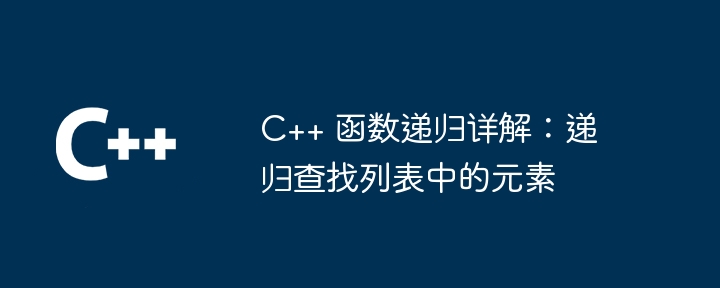
The steps to recursively find list elements are as follows: Recursive basic condition: If the list is empty, the element does not exist. Recursive procedure: Use a recursive call to find the remainder of the list and adjust the returned index. Check the first element of the list: If the first element is equal to the element you are looking for, then the element is at index 0. Not Found: If neither recursion nor first element check is found, the element does not exist.

Detailed explanation of C function recursion: recursively find elements in the list
Introduction
Recursion is a powerful programming technique that allows functions to call themselves. This is particularly useful when looking for elements in a data structure or solving other problems that require a divide-and-conquer strategy. This article will explore the use of recursion in C, and use a practical case to gain an in-depth understanding of the process of recursively finding elements in a list.
Recursive function
A recursive function is a function that calls itself. This may seem confusing, but it's actually quite intuitive. Consider the following example:
int findElement(const vector<int>& list, int element) {
if (list.empty()) {
return -1; // Element not found
} else if (list[0] == element) {
return 0; // Element found at index 0
} else {
return 1 + findElement(vector<int>(list.begin() + 1, list.end()), element);
}
}In this function, it returns immediately if the list is empty or the first element is equal to the element being looked for. Otherwise, it calls itself to find the rest of the list and adjusts the returned index by adding 1 at the index.
Practical case
We use a practical case to understand the elements in the recursive search list:
#include <iostream>
#include <vector>
using namespace std;
int findElement(const vector<int>& list, int element) {
// 递归基础条件
if (list.empty()) {
return -1;
}
// 递归过程
int index = findElement(vector<int>(list.begin() + 1, list.end()), element);
if (index != -1) {
return index + 1; // 调整索引
}
// 如果没有递归找到,检查列表的第一个元素
if (list[0] == element) {
return 0;
}
// 找不到
return -1;
}
int main() {
vector<int> list = {1, 3, 5, 7, 9};
int element = 5;
int index = findElement(list, element);
// 输出结果
if (index != -1) {
cout << "元素 " << element << " 位于索引 " << index << " 处。" << endl;
} else {
cout << "元素 " << element << " 不存在。" << endl;
}
return 0;
}In this example, findElement The function is called recursively until the list is empty or an element is found. If the element is found, the function returns the adjusted index. Otherwise, it returns -1.
Output:
元素 5 位于索引 2 处。
Conclusion
Recursion is a powerful tool for solving problems in C, especially suitable for finding in data structures Elements. You can greatly improve your programming skills by understanding how recursive functions work and how to use them in real-world problems.
The above is the detailed content of Detailed explanation of C++ function recursion: recursively find elements in a list. For more information, please follow other related articles on the PHP Chinese website!
 What are the differences between c++ and c language
What are the differences between c++ and c language
 Recommended learning order for c++ and python
Recommended learning order for c++ and python
 Cost-effectiveness analysis of learning python and c++
Cost-effectiveness analysis of learning python and c++
 Is c language the same as c++?
Is c language the same as c++?
 Which is better to learn first, c language or c++?
Which is better to learn first, c language or c++?
 The difference and connection between c language and c++
The difference and connection between c language and c++
 C++ software Chinese change tutorial
C++ software Chinese change tutorial
 Cost-effectiveness analysis of learning python, java and c++
Cost-effectiveness analysis of learning python, java and c++




